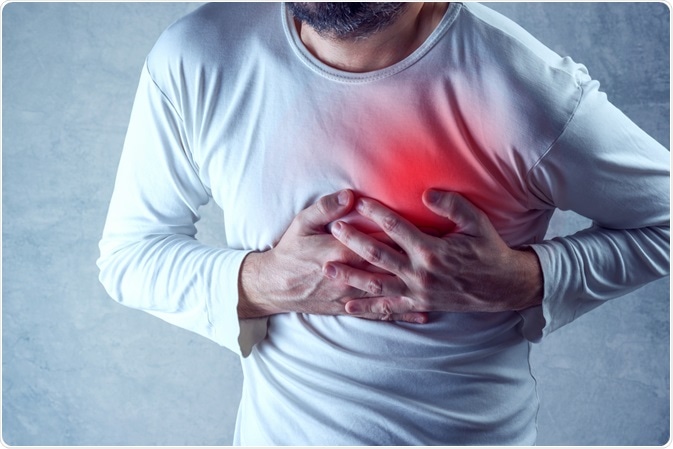.jpg) By Chloe Bennett, B.Sc.
By Chloe Bennett, B.Sc.Cardiovascular disease is the most prevalent cause of death worldwide, affecting approximately 17.9 million people in 2016. Due to the potential healthcare and economic burden, the American Heart Association has unveiled seven predictive parameters of heart health.

Image Credit: igorstevanovic/Shutterstock.com
Predicting the Risk of Cardiovascular Disease
A decade ago, the American Heart Association released its 2020 aims to increase America’s cardiovascular health. Within their announcement was the Association’s move from focusing on the primary prevention of cardiovascular disease (CVD) to primordial prevention.
A new model featuring seven measures of cardiovascular health was proposed, including a combination of health factors and behaviors.
A team of researchers, including three from Penn State University, investigated how the key health measures, including blood pressure, diet, and exercise were linked to participants’ cardiovascular health in a large, cohort study.
Analysis of the results revealed five patterns of how well the participants did on the measures throughout the study. The patterns were then used to successfully predict their future risk of developing CVD.
Measures of Heart Health
The American Heart Association’s seven key metrics of health includes three biometrics that people should aim to keep at optimum levels in addition to four behaviors that people have control over.
Biometrics included cholesterol, blood sugar, and blood pressure. While the adjustable behaviors include participating in regular exercise, maintaining a healthy weight, not smoking, and following a healthy diet.
Each measure was ascribed a poor, intermediate and ideal score. Smoking regularly would be graded “poor”, smoking within the past year would be “intermediate” and never smoking or quitting more than 12 months ago would be “ideal”.

Image Credit: Nopphon_1987/Shutterstock.com
The researchers combined the scores for each metric, 0 for poor, 1 for intermediate, and 2 for ideal, producing an overall “cardiovascular health score” (CHS).
As part of the study, the researchers collated the data of 74,701 Chinese adults. Each participant was required to complete a series of questions about their health alongside undergoing lab tests and clinical exams at three different points across the first four years. The next phase of the research involved the researchers tracking the incidence of CVD amongst the participants over the following five years.
Once collected, the researchers investigated how each CHS within the first four years was correlated with the incidence of CVD. They successfully identified five trajectories that the sample participants followed throughout the first four years. The patterns included maintaining, low, medium, or high cardiovascular health scores, in addition to decreasing and increasing CHS over time.
Each trajectory was also found to be correlated with varying risks of developing CVD in the future. For example, those maintained high CHS were 79% less likely to develop cardiovascular disease in the future compared to those who maintained low CHS. Those that worked on improving their scores over time, subsequently develop a lower chance of CVD.
Is One Measure More Important?
The researchers also wanted to investigate whether one out of the seven health metrics was significantly more important than the others. Repeated analyses were run whereby a single measure was removed each time. They found that all the scores predicted the risk of CVD in comparable ways.
This suggests that overall cardiovascular health is vital, and the evidence helps validate the seven metrics as a good predictor of CVD. The authors note that the metrics could also be incorporated in CVD prevention strategies.
What is Cardiovascular Disease?
CVD is a medical umbrella term used to describe conditions that affect the blood vessels and the heart. CVD is comprised of four main conditions: strokes, including mini-strokes, aortic disease, coronary heart disease, and peripheral arterial disease.
Strokes
A stroke can be caused when part of the blood supply to the brain is cut off, potentially resulting in brain damage caused by cell death. Mini-strokes occur when the blocking of the blood flow is transient.
Two main mechanisms result in strokes: hemorrhagic caused by a weakened blood vessel bursting, and ischemic, whereby blood flow is blocked due to a blood clot. The latter cause is typically more prevalent.
Those most a risk of developing a stroke include those with diabetes, high blood pressure, atrial fibrillation, and high cholesterol.
Aortic Disease
Aortic disease is comprised of conditions that affect the aorta. The most prevalent disease is an aortic aneurysm which occurs when the vessel walls of the aorta become weak and balloon. Those with an aortic aneurysm are often asymptomatic, and as the vessel can burst at any point, it can lead to life-threatening internal bleeding.
Coronary Heart Disease
Coronary heart disease is caused by when the blood flow to the heart becomes constricted or blocked. As a result, the heart is put under growing pressure increases the risk of heart failure, heart attacks, and angina.
Peripheral Arterial Disease
Peripheral arterial disease (PAD) is caused by a restriction in blood flow in arteries of the limbs, mainly the legs. Those with PAD experience recurrent ulcers on their legs and feet, numbness of the legs, pain, and cramping in the legs, and hair loss on the feet and legs.
Other Risk Factors of Cardiovascular Disease
Several other risk factors of CVD have been successfully identified. Researchers have found that those who work shift patterns have an increased risk of inflammation, high blood pressure, and cardiovascular disease compared to those working non-shift patterns.
It is suggested that shift work results in temporary misalignment of circadian rhythm inducing inflammation and increase blood pressure within 24 hours.
Other behavioral risk factors include drinking alcohol, smoking cigarettes, exercising infrequently and following an unhealthy diet. These factors are considered to contribute to obesity, increased blood sugar levels, and blood lipids which are independent risk factors for the onset of strokes, heart failure, and heart attack.
For those wishing to reduce their risk of CVD, reducing dietary salt, engaging in regular exercise, and reducing or stopping smoking and alcohol consumption can have positive outcomes.
References and Further Reading
- WHO (2017). Cardiovascular diseases. https://www.who.int/news-room/fact-sheets/detail/cardiovascular-diseases-(cvds)
- Wu, S., An, S., Li, W., Lichtenstein, A.H., Gao, J., Kris-Etherton, P.M., Wu, Y., Jin, C., Huang, S., Hu, F.B. and Gao, X. (2019). Association of Trajectory of Cardiovascular Health Score and Incident Cardiovascular Disease. JAMA network open, 2(5). 10.1001/jamanetworkopen.2019.4758
- Lloyd-Jones, D. M. et al. (2010). Defining and setting national goats for cardiovascular health promotion and disease reduction: the American Heart Association's Strategic Impact Goal through 2020 and beyond. Circulation, 121, 586-613. 10.1161/CIRCULATIONAHA.109.192703
- NHS (2019). Stroke: Overview. https://www.nhs.uk/conditions/stroke/
- NHS (2018). Cardiovascular disease. https://www.nhs.uk/conditions/cardiovascular-disease/
- Morris, C. J., Purvis, T. E., Hu, K., & Scheer, F. A. (2016). Circadian misalignment increases cardiovascular disease risk factors in humans. Proceedings of the National Academy of Sciences, 113(10). https://doi.org/10.1073/pnas.1516953113
Last Updated: Apr 15, 2020